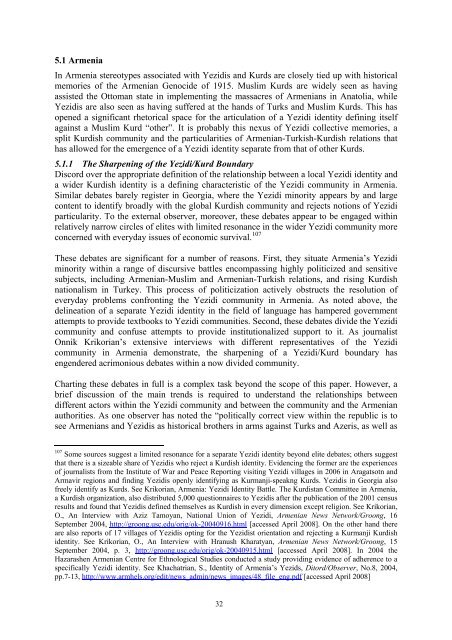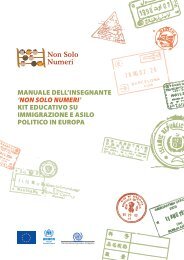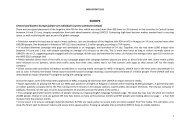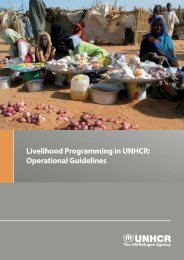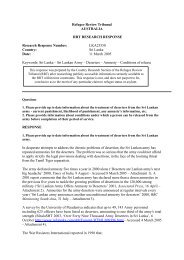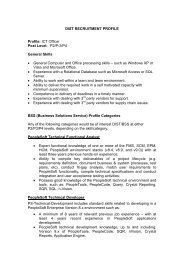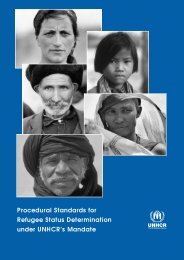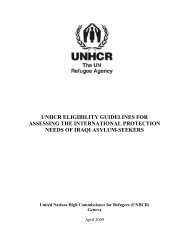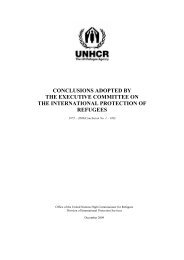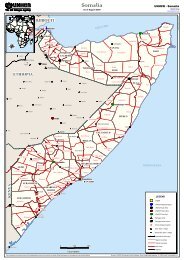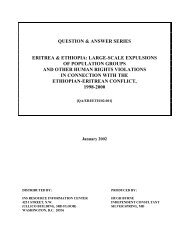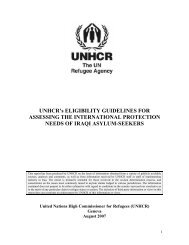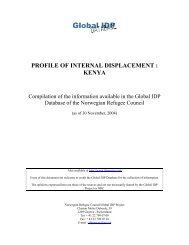The Human Rights situation of the Yezidi minority - UNHCR
The Human Rights situation of the Yezidi minority - UNHCR
The Human Rights situation of the Yezidi minority - UNHCR
You also want an ePaper? Increase the reach of your titles
YUMPU automatically turns print PDFs into web optimized ePapers that Google loves.
5.1 Armenia<br />
In Armenia stereotypes associated with <strong>Yezidi</strong>s and Kurds are closely tied up with historical<br />
memories <strong>of</strong> <strong>the</strong> Armenian Genocide <strong>of</strong> 1915. Muslim Kurds are widely seen as having<br />
assisted <strong>the</strong> Ottoman state in implementing <strong>the</strong> massacres <strong>of</strong> Armenians in Anatolia, while<br />
<strong>Yezidi</strong>s are also seen as having suffered at <strong>the</strong> hands <strong>of</strong> Turks and Muslim Kurds. This has<br />
opened a significant rhetorical space for <strong>the</strong> articulation <strong>of</strong> a <strong>Yezidi</strong> identity defining itself<br />
against a Muslim Kurd “o<strong>the</strong>r”. It is probably this nexus <strong>of</strong> <strong>Yezidi</strong> collective memories, a<br />
split Kurdish community and <strong>the</strong> particularities <strong>of</strong> Armenian-Turkish-Kurdish relations that<br />
has allowed for <strong>the</strong> emergence <strong>of</strong> a <strong>Yezidi</strong> identity separate from that <strong>of</strong> o<strong>the</strong>r Kurds.<br />
5.1.1 <strong>The</strong> Sharpening <strong>of</strong> <strong>the</strong> <strong>Yezidi</strong>/Kurd Boundary<br />
Discord over <strong>the</strong> appropriate definition <strong>of</strong> <strong>the</strong> relationship between a local <strong>Yezidi</strong> identity and<br />
a wider Kurdish identity is a defining characteristic <strong>of</strong> <strong>the</strong> <strong>Yezidi</strong> community in Armenia.<br />
Similar debates barely register in Georgia, where <strong>the</strong> <strong>Yezidi</strong> <strong>minority</strong> appears by and large<br />
content to identify broadly with <strong>the</strong> global Kurdish community and rejects notions <strong>of</strong> <strong>Yezidi</strong><br />
particularity. To <strong>the</strong> external observer, moreover, <strong>the</strong>se debates appear to be engaged within<br />
relatively narrow circles <strong>of</strong> elites with limited resonance in <strong>the</strong> wider <strong>Yezidi</strong> community more<br />
concerned with everyday issues <strong>of</strong> economic survival. 107<br />
<strong>The</strong>se debates are significant for a number <strong>of</strong> reasons. First, <strong>the</strong>y situate Armenia’s <strong>Yezidi</strong><br />
<strong>minority</strong> within a range <strong>of</strong> discursive battles encompassing highly politicized and sensitive<br />
subjects, including Armenian-Muslim and Armenian-Turkish relations, and rising Kurdish<br />
nationalism in Turkey. This process <strong>of</strong> politicization actively obstructs <strong>the</strong> resolution <strong>of</strong><br />
everyday problems confronting <strong>the</strong> <strong>Yezidi</strong> community in Armenia. As noted above, <strong>the</strong><br />
delineation <strong>of</strong> a separate <strong>Yezidi</strong> identity in <strong>the</strong> field <strong>of</strong> language has hampered government<br />
attempts to provide textbooks to <strong>Yezidi</strong> communities. Second, <strong>the</strong>se debates divide <strong>the</strong> <strong>Yezidi</strong><br />
community and confuse attempts to provide institutionalized support to it. As journalist<br />
Onnik Krikorian’s extensive interviews with different representatives <strong>of</strong> <strong>the</strong> <strong>Yezidi</strong><br />
community in Armenia demonstrate, <strong>the</strong> sharpening <strong>of</strong> a <strong>Yezidi</strong>/Kurd boundary has<br />
engendered acrimonious debates within a now divided community.<br />
Charting <strong>the</strong>se debates in full is a complex task beyond <strong>the</strong> scope <strong>of</strong> this paper. However, a<br />
brief discussion <strong>of</strong> <strong>the</strong> main trends is required to understand <strong>the</strong> relationships between<br />
different actors within <strong>the</strong> <strong>Yezidi</strong> community and between <strong>the</strong> community and <strong>the</strong> Armenian<br />
authorities. As one observer has noted <strong>the</strong> “politically correct view within <strong>the</strong> republic is to<br />
see Armenians and <strong>Yezidi</strong>s as historical bro<strong>the</strong>rs in arms against Turks and Azeris, as well as<br />
107 Some sources suggest a limited resonance for a separate <strong>Yezidi</strong> identity beyond elite debates; o<strong>the</strong>rs suggest<br />
that <strong>the</strong>re is a sizeable share <strong>of</strong> <strong>Yezidi</strong>s who reject a Kurdish identity. Evidencing <strong>the</strong> former are <strong>the</strong> experiences<br />
<strong>of</strong> journalists from <strong>the</strong> Institute <strong>of</strong> War and Peace Reporting visiting <strong>Yezidi</strong> villages in 2006 in Aragatsotn and<br />
Armavir regions and finding <strong>Yezidi</strong>s openly identifying as Kurmanji-speakng Kurds. <strong>Yezidi</strong>s in Georgia also<br />
freely identify as Kurds. See Krikorian, Armenia: <strong>Yezidi</strong> Identity Battle. <strong>The</strong> Kurdistan Committee in Armenia,<br />
a Kurdish organization, also distributed 5,000 questionnaires to <strong>Yezidi</strong>s after <strong>the</strong> publication <strong>of</strong> <strong>the</strong> 2001 census<br />
results and found that <strong>Yezidi</strong>s defined <strong>the</strong>mselves as Kurdish in every dimension except religion. See Krikorian,<br />
O., An Interview with Aziz Tamoyan, National Union <strong>of</strong> <strong>Yezidi</strong>, Armenian News Network/Groong, 16<br />
September 2004, http://groong.usc.edu/orig/ok-20040916.html [accessed April 2008]. On <strong>the</strong> o<strong>the</strong>r hand <strong>the</strong>re<br />
are also reports <strong>of</strong> 17 villages <strong>of</strong> <strong>Yezidi</strong>s opting for <strong>the</strong> <strong>Yezidi</strong>st orientation and rejecting a Kurmanji Kurdish<br />
identity. See Krikorian, O., An Interview with Hranush Kharatyan, Armenian News Network/Groong, 15<br />
September 2004, p. 3, http://groong.usc.edu/orig/ok-20040915.html [accessed April 2008]. In 2004 <strong>the</strong><br />
Hazarashen Armenian Centre for Ethnological Studies conducted a study providing evidence <strong>of</strong> adherence to a<br />
specifically <strong>Yezidi</strong> identity. See Khachatrian, S., Identity <strong>of</strong> Armenia’s Yezids, Ditord/Observer, No.8, 2004,<br />
pp.7-13, http://www.armhels.org/edit/news_admin/news_images/48_file_eng.pdf [accessed April 2008]<br />
32


